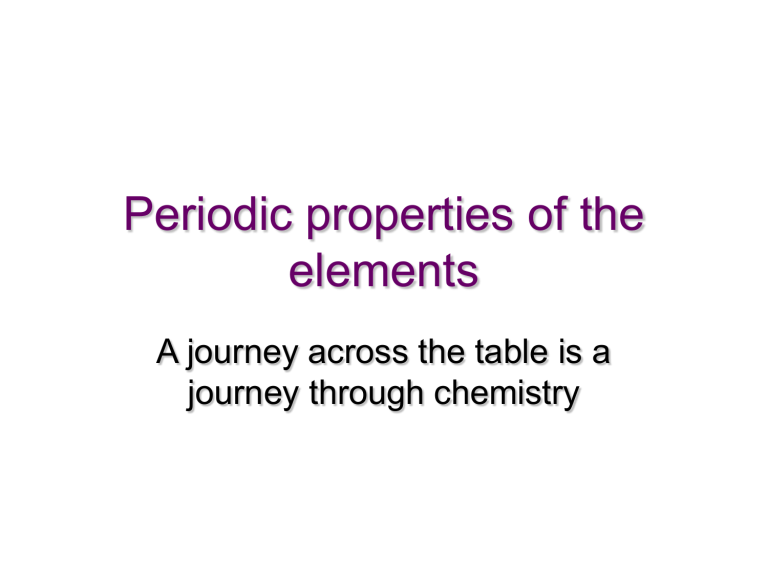Periodic properties of the elements

Periodic properties of the elements
A journey across the table is a journey through chemistry
The shape of the table is explained by the orbital model
2 groups
10 groups
14 groups
6 groups
Number of elements per row matches the capacity of the orbitals
Relating chemical and physical properties to the table
• Mendeleev’s table was constructed 50 years before the discovery of the nucleus
• The arrangement of elements was by atomic weight
• Atomic number (Moseley 1915) provides a more systematic ordering
• Note: X-ray photon energy varies smoothly with atomic number, providing a method of identifying elements
Explaining periodicity: effective nuclear charge and shielding
• Inner shell (core) electrons screen the outer (valence) electrons from the nuclear charge
– Shielding is more effective for electrons with higher angular momentum (higher l value: 3d > 3p > 3s)
– Decreases as the valence shell fills
• Increased shielding means lower effective nuclear charge
Effective nuclear charge
• Effective nuclear charge
Z eff
= Z – S
– Z = atomic number
– S = screening constant (roughly number of core electrons)
• Model is approximate because the valence electrons penetrate the inner shells
– Actual Z eff
> Z - S
Z
eff
and angular momentum
• Electron in 2s orbital spends more time close to nucleus than electron in 2p
• 2s orbital lower in energy than 2p
• Shielding of 2s lower than 2p
• Shielding follows order: 3d>3p>3s
Shielding and effective nuclear charge
• The “shell” picture helps to explain these observations
• Electrons in same shell experience stronger attraction to nucleus as shell fills
Correlate atomic radius and effective nuclear charge (Z eff
)
Atomic radii and periodic variation
Isoelectronic ionic series: same electrons, different charge
• In a period the ions will tend to be isoelectronic (all have filled shells)
– Na + , Mg 2+ , Al 3+
– P 3, S 2, Cl -
• For the cations, Z eff
• For the anions, Z eff
↑, radius ↓ as Z ↑
↑, radius ↓ as Z ↑
Ionization energy
• Ionization energy (I):
The energy required to remove an electron from an isolated gaseous atom
M(g) = M(g) + + e
• As I increases, atoms are harder to ionize
• Successive ionizations for electrons are represented by I i
(i = 1,2,3,…)
I
1
< I
2
< I
3
<…
Ionization energy and shells
• There is always a huge increase in I i when i represents an electron in an inner shell
Kink and ionization energy
• Unlike atomic radius the trend is not as smooth
• Note the dip at Be – B and N – O
• Random or rational?
– B adds electron to 2p
– O pairs electron (2p 4 )
Electron affinity
• Electron affinity:
The electron affinity is the energy released when an electron is added to a gaseous neutral atom
X(g) + e = X(g) -
• Unlike ionization, addition of an electron is usually favourable – even for electropositive elements
Periodicity and electron affinity
• Smooth trends are not in evidence
• Affinity tends to be zero or positive when electron is added to new (Be, Mg, He, Ne etc) or half-filled (N) shell
Electronegativity and periodicity
Density and periodicity
Trend in melting point not as easily explained
Periodicity and chemical properties
• Most obvious trend is from metallic to nonmetallic
• Acid-base properties of oxides:
– Metal oxides tend to be basic
• (Na
2
O = NaOH in H
2
O)
– Nonmetal oxides tend to be acidic
• (SO
2
= H
2
SO
3 in H
2
O)





